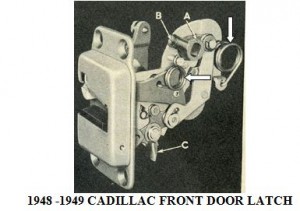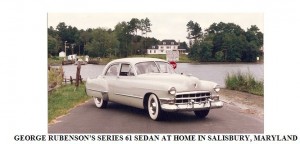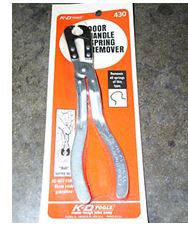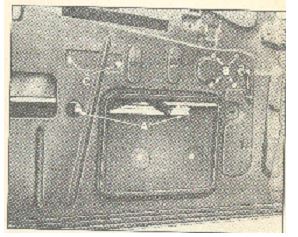We’ve touched upon this problem in past issues of the Times, but there’s always new information coming to hand. Drooping door handles, particularly that of the driver’s door which gets more use, is an annoying problem on ’48 and ’49 Cadillacs. Referring to the photo on the next page of a front latch, it is caused by the door handle’s square steel shaft that goes inside the door to enter the square opening in a softer pot metal piece in the latch called the tumbler, indicated by Arrow A.
Over the years, constant use causes the square opening in the tumbler to become partially rounded, resulting in the weight of the handle causing it to droop. (Arrow B points to the hole in the tumbler for the door handle set screw and Arrow C to the lock plate controlled by the outside key lock.)
There are several fixes, as set forth in the next paragraph, all of which, unfortunately, require removing the door panels and getting into the innards of the door. Though this is a lengthy job, as lots of screws must be unscrewed and lots of parts removed, unless you have to deal with taking apart the door latch itself it is not technically difficult. (The larger arrows in the photo point to two difficult-to-deal-with springs in the mechanism that must be removed and replaced when taking apart the latch.) Note that convertibles and Coupe de Villes have different door latches than club coupes and sedans. The above photo comes from the 1948 Fisher “C” Body Manual for Cadillacs and Oldsmobile 98s, which has excellent, well written, illustrated step-by-step procedures for doing this type of work. They can usually be found on Ebay and I suggest you buy one.
1. The best fix is to find another door latch in better or new condition. This way you avoid taking apart the latch which, as mentioned above, can be tricky. I once lucked out at a flea market and found a brand new ’49 Buick driver’s door latch for a club coupe (such as mine) or a sedan. 1949 Buick Supers and Roadmasters as well as ’48 and 49 Oldsmobile 98s used the same door latch as ’48 and 49 Cads. In my experience Buick and Olds parts frequently sell for less than the identical Cadillac parts, so you can try dealers that sell stuff for those cars. I was recently told that in the 1948 version of the latch the tumbler is made of bronze, which is much more durable than the’49 pot metal tumbler.
2. If the car is a convertible or Coupe de Ville, ’49er Ron Brooks of Twin Lake MI makes a sturdier tumbler to replace the original pot metal tumbler, which he sells for $125 or so. His phone number is 231-821-2812.
3. For other models of ’48 or ’49 Cadillac, All Cadillacs of the ‘40s and ‘50s www.allcads.com sells a sturdier replacement tumbler for $50 or so.
While both of the above are excellent replacement parts which are far superior to the original part, as mentioned above removing the latch from the door then installing the new part is not easy and requires much patience.



